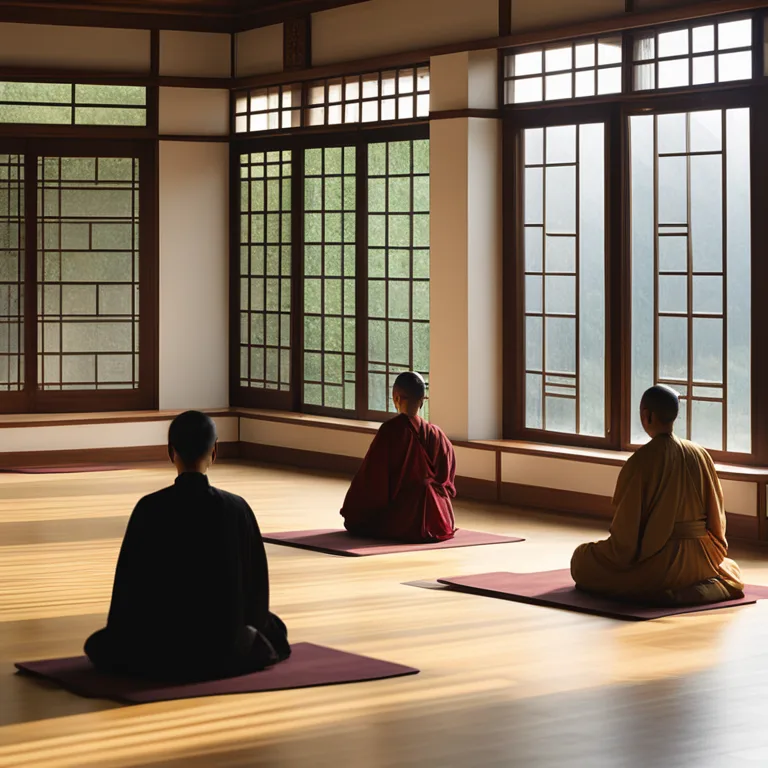
Korean Meditation Techniques: A Guide
Discover the tranquility of Korean meditation practices for focus and peace in this concise article.
article by Hina Kurosawa
Introduction to Korean Meditation
Meditation, a practice rooted in various traditions worldwide, has found a unique expression in Korea. The Korean approach to meditation blends an appreciation for nature, historical philosophies, and indigenous shamanistic beliefs. It offers distinct methods that foster inner peace, balance, and mindfulness. This article delves into several Korean meditation techniques, tailored for modern practitioners seeking solace in today's fast-paced world.

Seon Buddhism and Zazen
A cornerstone of Korean meditation is Seon Buddhism, closely related to Japanese Zen. Central to Seon is the practice of Zazen, or seated meditation. The focus here lies in observing one's thoughts without attachment, aiming to reach a state of 'no-mind' or Mushin. This detachment from the chaos of thought allows practitioners to experience the present moment more fully, promoting mental clarity and emotional stability.

Jungto Society's Modern Adaptations
The Jungto Society, a modern Buddhist movement in Korea, has adapted traditional principles for contemporary lives. They emphasize the importance of connecting with others and the environment through 'Jungto meditation,' which incorporates communal living and environmental responsibility. In practicing with the Jungto Society, meditation becomes an act of social engagement, encouraging a holistic approach to well-being that resonates with the interconnectedness of our current global context.

Chunhwa Sundo Breathing
Chunhwa Sundo, a Korean Taoist practice, prioritizes harmonizing the body and mind through breath. This technique involves controlled breathing patterns combined with focused body movements to cultivate Ki, or life energy. The rhythmic nature of Chunhwa Sundo promotes concentration and the flow of energy throughout the body, which can be especially beneficial in alleviating modern stressors and fatigue.

Mindfulness in Everyday Rituals
Koreans often cultivate meditation through daily activities, embracing the mindful execution of rituals like tea ceremonies or calligraphy. Such practices are not merely for cultural preservation but serve as vehicles for meditation. Engaging in these tasks with complete attention allows one to practice a form of moving meditation, where the mundane becomes a conduit for mindfulness and the cultivation of inner calm.
Modern Integration and Meditation Apps
As we look to the future, Korean meditation techniques continue to evolve. The rise of digital platforms has led to the development of meditation apps that offer guided sessions in both English and Korean, making these ancient practices more accessible than ever. These tools aim to help individuals incorporate meditation into their daily routines, providing a touch of Korean serenity in a digitized format suitable for our technology-driven age.
Conclusion: Embracing Serenity
From the focused silence of Zazen to the integration of mindfulness in daily rituals, Korean meditation offers a plethora of practices suited for the contemporary seeker. By adopting these techniques, one can find a pathway to tranquility and enhanced mental health that is both time-honored and pertinent to the dynamic challenges of the modern era. As we continue to navigate the complexities of life, embracing the serenity derived from Korean meditation might just be the solace we need.
Published: 12/20/2023
Modified: 12/20/2023
More predictions
Come back here soon to learn more about yourself and your future


Best Meditation Techniques for Peace
Discover powerful meditation practices to enhance calmness and clarity in your daily life. Perfect for beginners and seasoned practitioners.


Sport life: Meditation Techniques for Athletes
Learn how meditation can enhance athletic performance, improve focus, and accelerate recovery. Discover key techniques tailored for the physical demands of athletes.


Soothing Meditation Practices for Serenity
Discover effective meditation techniques to cultivate a tranquil mind and embrace inner peace in our fast-paced world.